Template:Predator
The Metroid is an ectoparasitoidic, predatory life form created by the Chozo to combat the X Parasite on SR388. However, due to their ability to collect life energy and feed off of it, Metroids have been harvested for experiments and use as bioweapons by the Space Pirates and later the Galactic Federation.
History
Origins
On SR388, the X Parasites threatened to destroy the ecosystem, due to the high rate of reproduction. However, The Chozo colonized the planet, and then created Metroids to keep the parasites in check. "Metroid" is the Chozo word for "ultimate warrior." The Metroids kept the X Parasite numbers in check, and became the dominant predators of SR388.
Cultivation and Extinction
The Metroids were first found on SR388 by a Galactic Federation scout ship. However, while en route with a Metroid, the scout ship was hijacked by the Space Pirates.
The Space Pirates saw Metroids as a weapon they could use, due to their parasitic properties. The Space Pirates captured and cloned many Metroids, with some damage to their own numbers. With the Metroids as well as juvenile Pirates, the Space Pirates engaged in experimentation, using phazon for mutations.
Other forms of Metroids mutated due to the phazon, such as the Hunter Metroid and the Fission Metroid. Metroids were brought to Zebes, Tallon IV, and Aether, where they were experimented on and cloned. While on Tallon IV, a life form called the Metroid Prime was discovered in the core of the planet.
Seeing the dangers the Metroids posed to the galaxy, the Galactic Federation attempted to destroy them. After two failed attempts by the Federation's army to eradicate the Metroids on their home planet of SR388, they called on Samus Aran to deal with them, as she had previously been the only person able to survive an encounter with the creatures. Samus destroyed all the Metroids on the planet, including the Queen, save one; a larvae that had imprinted Samus as its mother. Samus brought back this larval Metroid to Ceres Space Station to be used for research.
This didn't last long however. Soon Ridley of the Space Pirates captured the larva Metroid and brought it back to Zebes to be cloned. There, the Space Pirates first unsuccessfully cloned the Metroid, creating the Mochtroids. They did manage to clone the Metroids successfully eventually, only to be destroyed by Samus. During Samus's battle with Mother Brain, the Metroid that believed Samus to be her mother gave Samus back life energy during a critical moment, leaving Samus to destroy the Mother Brain. However, the Metroid did not survive the encounter, leaving the Metroids to be presumably wiped out from the Galaxy. It should be noted that the Metroid which saved Samus Aran was massive, likely due to the considerable amount of energy it was able to feed off of over the short time span since its arrival on Zebes. Effectively it could be called a Super Metroid.
After Effects
Once all the Metroids were gone from SR388, the X Parasite could reproduce again, and became a threat to the ecosystem. Samus Aran attempted to fight the parasite, but was unsuccessful. The parasite entered Samus's body, leaving Samus's body integrated with her suit as she passed out and the suit could only be removed while she was awake (very likely a safety protocol). Most of it were surgically removed, but she was dying. There was a solution, however: a Metroid vaccine. The Metroid vaccine killed the X parasite, and saved Samus's life - again.
The larval Metroid that Samus had brought back from SR388 had been cloned on the BSL Research Station orbiting SR388, presumably by DNA sequences sent to them by the Ceres Station. The Federation managed to clone each form of Metroid up to the Omega Metroid using artificial biospheres of SR388's many ecosystems. Whether they managed to clone a Queen, or why, is unknown. The Metroid cloning center was jettisoned into space and self-destructed after a SA-X breached it.
Biology and Life Cycle on SR388
The Metroid has a several-stage lifestyle. On Planet SR388 a Metroid will evolve like this:

a metroid egg
Egg-Larva
Metroids start out as eggs, presumably laid by the Queen. They then eventually hatch into small Metroid larvae. The larva is small, and floats in the air. Its tentacles will turn into teeth.
Metroid
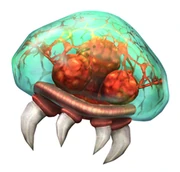
A Metroid
The Metroid has a thick gelatinous membrane, resembling a sort of solid jellyfish, which contains a set of red, raspberry-like nuclei. They have two pairs of mandibles, one for gripping their prey while the other extracts its life energy. Metroids hover in the air, defying gravity by using kinetic energy they store in their body.

Metroids in a Laboratory in BSL research station. Normal Metroid (lower right), Alpha Metroid (lower left), Gamma Metroid (upper left), Zeta Metroid (upper right)
Once attached to their prey, they are very difficult to dislodge and will otherwise drain their victim of their life energy completely, killing it. They have an endless appetite and will feed on any and all living creatures they come across, with the single exception of their own species. This immense threat is compounded by their invulnerability to most forms of known weaponry. They have only one real weakness: an extreme sensitivity to cold temperatures. Once their membrane is frozen it can be shattered with explosives, such as a small explosive projectile.
When a Metroid takes in energy, it grows in size. Eventually, it will metamorphose to its next form. However, the exact transformation is entirely dependent on the planet or location in which they are growing in, to maximize their adaptive abilities.
Alpha Metroid

an Alpha-Metroid
The Alpha Metroid is the next stage in the Metroid's natural life cycle, which takes place on SR388. While Alpha Metroids can hover like their previous form, they have four limbs, strange tusks, a horn, and two pairs of eyes.
Gamma Metroid

The Gamma Metroids are a grown version of the Alpha Metroid. The limbs are now longer and more muscular, the carapace is thicker and bigger, and the horns are stronger and thicker. Another pair of eyes is added to the head of the Metroid. Gamma Metroids also have gained the ability to generate bolts of energy as a means of attack.
Zeta Metroid

a Zeta Metroid
Zeta Metroids are more of a dinosaur-like analog. This form of the Metroid has only a small bit of the blue membrane from the unmorphed Metroid left over. The Zeta has two muscular legs, two short arms with claws at the ends, and a tail. Having lost the ability to hover, they use their legs to leap with great speed as well as strength. The Zeta Metroid has also lost the Gamma Metroid's energy bolt attack, but this shortcoming is compensated by it now being able to spit a powerful corrosive acid.
Omega Metroid
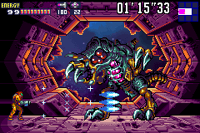
Samus Aran facing an Omega Metroid.

a Omega Metroid
Besides the Queen Metroid, this is the fullest a Metroid can naturally evolve. The blue membrane, usually on the underbelly on the Metroids, is now concealed. The legs, arms, and tail are now fully developed. Another pair of eyes are added, making a total of four pairs of eyes. An Omega Metroid's large leg muscles make it a quick runner and a mighty jumper.
Queen Metroid

the Metroid Queen
The Queen Metroid is so far the only form of Metroid known to be able to reproduce normally. The Queen is much larger than any other form of Metroid, and stands on all fours as opposed to walking on two, like the Zeta and Omega Metroids. The neck of the Queen can extend to impressive lengths, to better protect her young.
Mutated Evolution
Tallon IV Metroid

a infant Tallon Metroid
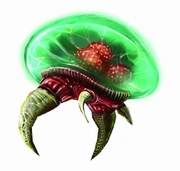
An adult Tallon Metroid

Hunter Metroids
The Metroids from Tallon IV evolve along a different path, transforming into a Hunter Metroid as opposed to an Alpha, although this is due to their exposure to phazon and lack of certain elements from SR-388's environment. Through dedicated research it has been discovered that the process of feeding phazon to metroids is not at all enjoyable to them. Federation scientists have stated that the Metroid's reaction to phazon is "much like a Human's reaction to a cocaine milkshake." The Tallon Metroid exposed to orange phazon evolves into a Fission Metroid.
Hunter Metroid
The Hunter metroid is slightly larger than a Tallon metroid, and has a red-orange membrane. Its mandibles have turned into tentacles, and it has the ability to vampirize life-energy from a distance.
Fission Metroid
This Tallon Metroid variant was exposed to orange phazon and has the ability to reproduce using mitosis. It has only been seen within the impact crater on Tallon IV, where Metroid Prime resides.
Metroid Prime
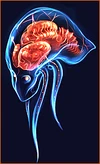
Metroid Prime's essence.
Metroid Prime´s origin is unknown. It could have evolved from a Metroid Larva exposed to severe doses of Phazon; this theory is suggested by Space Pirate Log which mentioned that Metroid Prime was at first at a small form, and now it is growing bigger. At first, Metroid Prime is covered in a durable exoskeleton. When fighting with Samus Aran, is exoskeleton was heavily damaged, and then its essence was leaked.
While unencumbered by its exoskeleton, Metroid Prime is able to create Tallon Metroids and its variants, make wave attacks, and become invisible to the naked eye (likely by bending light around itself). Metroid Prime's essence is extremely resistant to effects due to phazon mutation, causing it to only be able to be wounded by phazon-based weaponry. Samus used phazon pools created by the Metroid Prime, activated her Phazon Beam and killed it. With its last breath (assuming of course that they breathe) Metroid Prime stole Samus' Phazon Suit from her and while she escaped used it to formed into Samus' new enemy: Dark Samus.
There are rumors that Metroid Prime is part X Parasite; this is false. The reasoning behind the rumor is because when Samus defeated Metroid Prime and it reverted to an spheroid form, people thought it looked like a Core-X. One must keep in mind however that Dark Samus and the many SA-X's are two completely different characters. SA-X seems to have Samus' face. SA-X only uses techniques it copied over from Samus. Dark Samus has its own style.
Dark Samus
Using the Phazon suit that it stole from Samus, Metroid Prime evolved into Dark Samus, a Phazon-based clone of the original Samus containing her genetic material. Samus' first encounter with her "evil twin" was on Planet Aether, which was recently damaged by a phazon meteorite. The meteorite created a Dark version of Aether. Somehow, in Dark Aether, a lifeform known as The Ing was born, devastating the true planet Aether.
Dark Tallon Metroid

An ing-infected Metroid.
The Ing have parasitic properties and infect potential fighting creatures, using them as a vessel for combat. When the host is killed, the Ing escapes and finds a new host. The Metroid are enemies of the Ing and attack them on sight. However, some ings have managed to successfully infect Metroids, making them even more powerful.
Unfreezable Metroid
In the events of Metroid: Other M, a research team had started a Metroid breeding program on a research station called the Bottle Ship. One of the results of the program was the Unfreezable Metroid, a new strain of Metroid that could not be harmed by freezing temperatures. Without this weakness, the Metroids were invincible. The majority of these Metroids were kept in an area called Sector Zero, which was jettisoned and destroyed by Adam Malkovitch. The last of the Unfreezables, a Queen Metroid found in a hidden lab area, was eradicated by Samus Aran.
Extrapolated Life Cycle Due to Phazon Exposure
Due to experimentation by the Space Pirates on Tallon IV, as well as numerous logs, it can be safely determined that the life cycle of a Metroid is altered by atmospheric conditions. The presence of phazon will cause a Metroid to undergo a number of different kinds of mutations, many of them varied.
Stage 1: Phazon/Tallon Metroid
It is said that the Phazon Metroid is related to the Tallon Metroid, due to its reliance on phazon. It is likely that this particular strain is either native to the planet Phaaze or was placed there by Space Pirates. Similarly, the related Tallon Metroid may have been native to the planet Tallon IV long before Space Pirates arrived with Metroids. Either possibility yields a similar end. The Phazon Metroid is characterized by its complete dependence on phazon. Phazon Metroids are able to attack enemies with energy bolts, and their ability to become intangible allows them to evade missiles and phase through walls.
Stage 2A: Metroid Hatcher
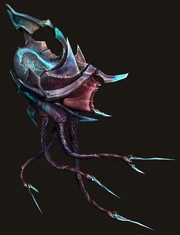
a Metroid Hatcher
The Metroid Hatcher is an enormous Metroid mutated through phazon exposure. The Metroid Hatcher has a large maw and long tentacles. It "births" live Metroids through its maw. This variant serves to increase the Metroid population quickly without the need for beta-ray fission or egg gestation time. It is unknown whether this variant also lays eggs. It is also unknown what conditions cause the phazon mutation to lead to this form rather than the "Hopping Metroid" (see next).
Stage 2B: Hopping Metroid
In this variant of Metroid mutated by phazon exposure, the creature has lost its ability to fly and has gained the use of powerful legs. It is believed that either this form or the "Phazon Metroid" lays eggs, due to their presence being unexplained by the "Hatcher Metroid", which "births" live young. It is believed that this form can only be found where metroids are exposed to massive quantities of phazon, such as Phaaze, or proximity to a Leviathan/Seed.
Stage 3: Metroid Prime
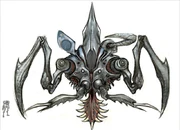
the Metroid Prime
Metroid Prime is currently thought of as the height of Phazon Metroid mutation. It is a direct mutation of the "Hopping Metroid" due to obvious similarities and evidence. There have been two documented instances of this creature.
One instance is on Tallon IV, where this creature was found lurking in the Impact Crater. We know that the planet was impacted by an interstellar object originating from the planet Phaaze. This object was presumably a natural Leviathan (natural having the meaning of lacking the Space Pirate technology gained in later years by the entity Dark Samus; technology which augments the Leviathan into a rapidly acting phazon seed). When this Leviathan was near death, sometime after impact, it followed its natural instinct by choosing a creature in close proximity and corrupting it with immense quantities of phazon to cause it to act as a guardian until the planet has been transformed. It is debatable how the dying Leviathan came into contact with a Metroid, but it would appear that it mutated first into a "Hopping Metroid", and then through continued massive exposure, into the creature known as Metroid Prime.
The second instance is found on the planet Phaaze, where dead husks can be found which are said to be identical to the creature fought in the crater on Tallon IV. This instance is simple to explain. The planet Phaaze is, in essence, entirely phazon-based. The level of phazon radiation there is enormous. Whether the Metroids found there are native to the planet or were brought by Space Pirates is irrelevant. Their presence confirms that the massive levels of phazon would eventually mutate each Metroid into a "Hopping Metroid", and then into a "Metroid Prime". All three forms are present on the planet Phaaze, including vast amounts of "Hopping Metroids" therefore presumably there were other "Metroid Prime" bioforms on the planet, perhaps elsewhere.